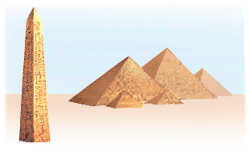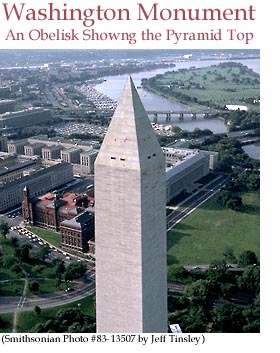


Egyptian Revival Period and Grave Markers
Napoleon’s 1798-99 intrusions into Egypt, followed by the British presence in Egypt inspired the
Egyptian Revival Period. Like the other classic revivals in the United States, the Egyptian Revival was a
temporary fashion - a fad. It lasted long enough to be replaced by the Victorian Period. Unfortunately, the Egyptian
Revival Period style monuments encouraged some misinformed folk to claim
that the Egyptian style markers were used by satanic, evil, anti-Christian, and/or Osiris worshipping heathens. Many of those folk
(anti-Masons) were opposed to Freemasonry and used the charges of anti-Christian against the Masons. If you find an
Egyptian style monument over grave of your ancestor, do not assume that he was a Satanist, &c. Also, the
use of Egyptian elements on monuments does not prove the interred was a Freemason. The Masonic Square and Compass
on a graver marker would be far better proof of Masonic membership.
From the web site of The Association of Gravestone Studies, we find this particularly objective quote:
“The obelisk is, to quote McDowell and Meyer in The Revival Styles in American Memorial Art, one of
the ‘most pervasive of all the revival forms’ of cemetery art. There is hardly a cemetery founded in the
1840s and 50s without some form of Egyptian influence in the public buildings, gates, tomb art, etc.
Napoleon’s 1798-99 Egyptian campaigns, the discoveries at the tombs of the Pharaohs, and our new
Republic’s need to borrow the best of the ancient cultures (Greek revival, classic revival, the prominence
of classical studies and dress, etc.) led to a resurgence of interest in the ancient Egyptian culture.
Obelisks were considered to be tasteful, with pure uplifting lines, associated with ancient greatness,
patriotic, able to be used in relatively small spaces, and, perhaps most importantly, obelisks were less
costly than large and elaborate sculpted monuments. There were many cultural reasons for the revival
styles of the nineteenth century. Freemasonry, while part of the overall cultural influence, was not
responsible for the prevalence of obelisks. If you would like to read more about some of these styles,
see The Egyptian Revival: Its Sources, Monuments and Meaning, 1808-1859, by Richard Carrott.”
You may find an extraordinary example of an Egyptian Pyramid, the Brunswig
Mausoleum, at the Metairie Cemetery in New Orleans, Louisiana.
Incidentally, true Egyptian Revival architecture in the south may be found at the
Downtown Presbyterian Church (1849) , 427 Church Street, Nashville, Tennessee, and at the
Egyptian Building (built, 1845), 1223 E. Marshall St., Richmond, Virginia. Later
the 1922 discovery of the tomb of Egyptian Pharaoh, King Tutankhamen, brought about another
Egyptian Revival of sorts. This revival had great influence in jewelry and architecture. Some of
our early grand movie palaces emphasized Egyptian architecture and motifs.


GEORGE WASHINGTON
and many of the Founding Fathers - men such as, Paul Revere, Joseph Warren and John Hancock - were Freemasons. The fitting
memorial for our first president is the obelisk - the Washington Memorial.




Return to:
Project Home Page
Page © 2002 Fred Smoot







